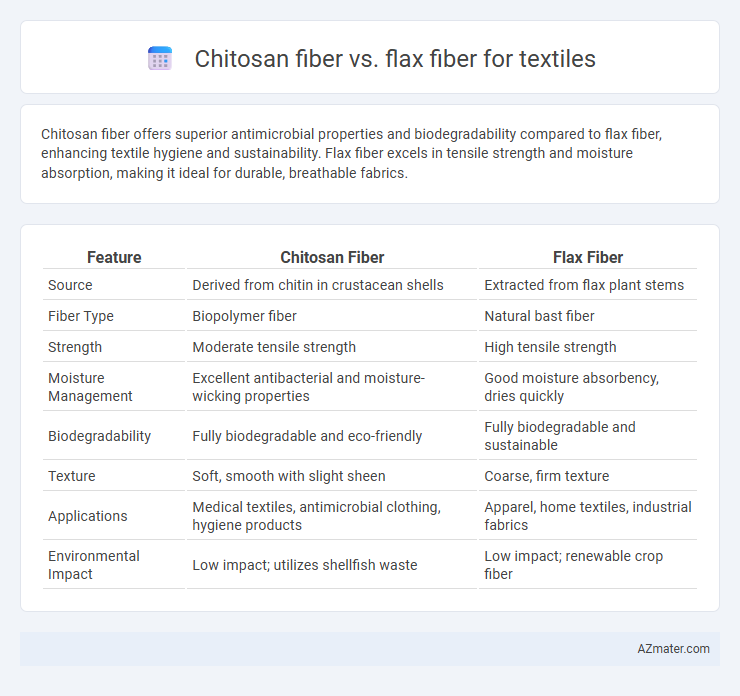Chitosan fiber offers superior antimicrobial properties and biodegradability compared to flax fiber, enhancing textile hygiene and sustainability. Flax fiber excels in tensile strength and moisture absorption, making it ideal for durable, breathable fabrics.
Table of Comparison
| Feature | Chitosan Fiber | Flax Fiber |
|---|---|---|
| Source | Derived from chitin in crustacean shells | Extracted from flax plant stems |
| Fiber Type | Biopolymer fiber | Natural bast fiber |
| Strength | Moderate tensile strength | High tensile strength |
| Moisture Management | Excellent antibacterial and moisture-wicking properties | Good moisture absorbency, dries quickly |
| Biodegradability | Fully biodegradable and eco-friendly | Fully biodegradable and sustainable |
| Texture | Soft, smooth with slight sheen | Coarse, firm texture |
| Applications | Medical textiles, antimicrobial clothing, hygiene products | Apparel, home textiles, industrial fabrics |
| Environmental Impact | Low impact; utilizes shellfish waste | Low impact; renewable crop fiber |
Introduction to Chitosan and Flax Fibers
Chitosan fiber, derived from chitin primarily found in crustacean shells, offers exceptional biodegradability, antimicrobial properties, and moisture management, making it a promising material for advanced textile applications. Flax fiber, obtained from the flax plant's bast, is renowned for its natural strength, breathability, and eco-friendly cultivation, widely used in linen production for sustainable fashion. Both fibers present unique attributes: chitosan's bioactive functionality contrasts with flax's lignocellulosic structure, influencing their respective uses in textile manufacturing.
Source and Production Methods
Chitosan fiber is derived from chitin, primarily sourced from crustacean shells through deacetylation, while flax fiber originates from the flax plant stalks via retting and scutching processes. Chitosan fiber production involves chemical extraction and spinning methods to achieve antibacterial properties, whereas flax fiber relies on traditional mechanical and enzymatic treatments to separate and soften the bast fibers. The sustainability of chitosan fiber depends on seafood industry waste utilization, contrasting with flax fiber's renewable agricultural crop basis and its energy-efficient processing techniques.
Physical and Mechanical Properties Comparison
Chitosan fiber exhibits superior antibacterial properties and moisture retention compared to flax fiber, making it highly suitable for medical textiles and activewear. Flax fiber boasts higher tensile strength and durability, offering excellent mechanical stability for traditional textile applications. While chitosan fiber provides enhanced elasticity and softness, flax fiber maintains better abrasion resistance and thermal conductivity in fabric production.
Moisture Absorption and Comfort
Chitosan fiber exhibits superior moisture absorption due to its hydrophilic nature and ability to regulate humidity, enhancing comfort in textile applications by keeping the skin dry and preventing bacterial growth. Flax fiber, while also breathable and moisture-wicking, has a higher tendency to retain moisture, which can lead to slower drying times and reduced comfort in humid conditions. The antimicrobial properties of chitosan further improve textile hygiene and wearer comfort compared to flax fiber.
Antimicrobial and Hypoallergenic Features
Chitosan fiber exhibits strong antimicrobial properties due to its natural ability to inhibit bacterial growth, making it highly suitable for hygienic textile applications. Flax fiber is naturally hypoallergenic and breathable, reducing skin irritation and enhancing comfort for sensitive users. Combining chitosan's antimicrobial effects with flax's hypoallergenic qualities results in innovative textile blends that promote health and comfort.
Environmental Sustainability and Biodegradability
Chitosan fiber exhibits superior environmental sustainability compared to flax fiber due to its production from renewable chitin sources like crustacean shells, which reduces waste and reliance on agricultural land. Both fibers are biodegradable, but chitosan fiber decomposes more quickly in natural environments because of its antimicrobial properties and polysaccharide structure. Flax fiber, while also biodegradable and contributing to sustainable textile practices, requires intensive water and pesticide use during cultivation, impacting its overall environmental footprint.
Dyeing and Color Fastness Qualities
Chitosan fiber exhibits superior dye uptake and enhanced color fastness compared to flax fiber, owing to its amino groups that form strong ionic bonds with dye molecules. Flax fiber, composed primarily of cellulose, tends to absorb dyes less uniformly and is more prone to fading due to weaker hydrogen bonding with dyes. Textile applications benefit from chitosan fiber's natural antimicrobial properties and improved resistance to washing and light exposure, resulting in longer-lasting vibrant colors than those achieved with flax fiber.
Cost and Economic Feasibility
Chitosan fiber, derived from chitin found in crustacean shells, typically incurs higher production costs compared to flax fiber due to complex extraction and processing methods. Flax fiber, known for its sustainable cultivation and established supply chain, offers more economic feasibility for large-scale textile manufacturing. Market demand and scalability heavily favor flax fiber as a cost-effective investment in eco-friendly textiles, whereas chitosan fiber remains niche with premium pricing.
Applications in Modern Textiles
Chitosan fiber offers antimicrobial properties and biodegradability, making it ideal for medical textiles and activewear, where hygiene and sustainability are critical. Flax fiber, known for its strength, moisture-wicking, and breathability, excels in lightweight apparel and eco-friendly interior fabrics. Both fibers enhance performance and environmental impact in modern textile applications, with chitosan emphasizing functional health benefits and flax providing durable, natural comfort.
Future Prospects and Market Trends
Chitosan fibers exhibit strong antimicrobial properties, biodegradability, and biocompatibility, making them highly promising for sustainable textile developments and medical applications. Flax fibers, known for their natural strength, breathability, and eco-friendly cultivation, continue to dominate the linen market, driven by increasing demand for organic and durable fabrics. Market trends indicate a growing shift towards bio-based fibers, with chitosan fiber poised for innovation in smart textiles and functional wear, while flax fiber maintains steady growth due to its renewable and environmentally friendly profile.

Infographic: Chitosan fiber vs Flax fiber for Textile
 azmater.com
azmater.com